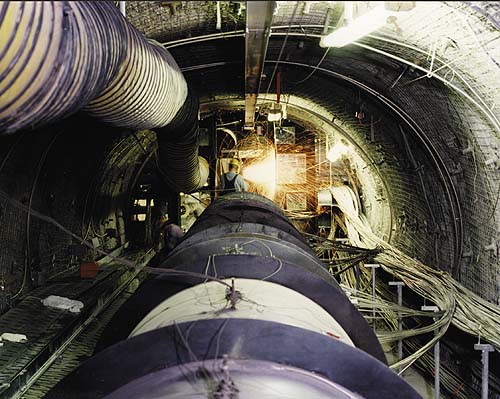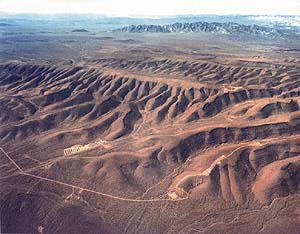 ucca Mountain stands on the edge of the Nevada Test Site, where, beginning in the 1950s, hundreds of nuclear weapons were exploded above and below ground. Since the early 1980s scientists have been investigating a more peaceful use for this barren landscape, as a final resting place for the nation's spent nuclear fuel. The nature and history of Yucca Mountain's rock formations, the flow of water through them, and the risks of earthquakes or volcanoes are only a few of the questions that must be answered.
ucca Mountain stands on the edge of the Nevada Test Site, where, beginning in the 1950s, hundreds of nuclear weapons were exploded above and below ground. Since the early 1980s scientists have been investigating a more peaceful use for this barren landscape, as a final resting place for the nation's spent nuclear fuel. The nature and history of Yucca Mountain's rock formations, the flow of water through them, and the risks of earthquakes or volcanoes are only a few of the questions that must be answered.
In collaboration with researchers from other National Laboratories, scientists from Berkeley Lab's Earth Sciences Division have taken a major role in a crucial series of tests that will determine the Yucca Mountain repository's fate. They have set out to determine how the heat generated by high-level nuclear waste is likely to affect the transport of radionuclides due to coupled changes in the thermal, chemical, mechanical, and hydrological properties of the rock under Yucca Mountain.

|
(Click on image to enlarge)
|
|
Beneath Yucca Mountain in a 47-meter-long tunnel, researchers have placed electrical heaters (as pictured above) inside containers resembling those intended to hold high-level nuclear wastes. Numerous instruments monitor the effect of heat on the surrounding rock. Tests like these will help determine the consequences of storing nuclear wastes in tunnels inside Yucca Mountain.
|
What will happen to the rock inside Yucca Mountain when it is subjected to heat over a long period of time? How much will it expand? Will its chemical composition change? Will it crack? Will pores open, allowing gases and liquids to flow more readily? "In 1995 the Department of Energy asked Berkeley Lab to participate in writing a white paper describing a research program to address these questions," says Yvonne Tsang, who heads the Berkeley Lab team involved in heater testing at the Yucca Mountain Exploratory Studies Facility. "The tests being done now are based on that paper."
The team outlined an approach that included not only field tests, but extensive computer modeling and laboratory experiments as well. "At Berkeley Lab we have done substantial work in coupled thermal and hydrological modeling, with expertise in flow and transport in heterogeneous systems. Here we have multiple processes operating within a complex geological system. We're modeling how these processes are coupled."
The testing has two main components. The Single Heater Test is a 700-cubic-meter block of stone cut out of an underground vault. A four-kilowatt electric heater five meters long was inserted into the center of the block and run for a year. The hot block is now cooling, with a final report due at the first of next year.
| Lead scientist on this project
|
|
|
|
|
|
The Drift Scale Test is much larger in extent, consisting of a tunnel (drift) 47.5 meters long with electrical heaters in mock-up waste containers. Numerous bore holes lead off from the tunnel, in which addditional "wing" electrical heaters produce heat deep in the surrounding rock. The planned operating power is 200 kilowatts. The heating phase of the Drift Scale Test will last through the year 2001, and final results will not be reported until 2006.
Instruments and sensors are mounted on the surfaces of the block and the tunnel and inserted in numerous boreholes; active tests include electrical-resistivity tomography and cross-hole radar tomography -- which create slice-like images of the rock interior -- neutron logging, gas and water sampling, and air permeability tests, all designed to probe the redistribution of moisture in the rock block. Data from thermocouples, extensometers, humidity sensors, pressure transducers, and a variety of other devices is continually recorded.
"The object of these in situ tests is to better understand the coupled processes," says Tsang. "By repeatedly comparing our interpretive models to actual data, we build confidence in our understanding of the complex, related processes involved, and thus in our ability to predict the performance of the waste repository." Both understanding and confidence are essential for evaluating whether or not Yucca Mountain is a safe place to store nuclear waste.
- Paul Preuss



 ucca Mountain stands on the edge of the Nevada Test Site, where, beginning in the 1950s, hundreds of nuclear weapons were exploded above and below ground. Since the early 1980s scientists have been investigating a more peaceful use for this barren landscape, as a final resting place for the nation's spent nuclear fuel. The nature and history of Yucca Mountain's rock formations, the flow of water through them, and the risks of earthquakes or volcanoes are only a few of the questions that must be answered.
ucca Mountain stands on the edge of the Nevada Test Site, where, beginning in the 1950s, hundreds of nuclear weapons were exploded above and below ground. Since the early 1980s scientists have been investigating a more peaceful use for this barren landscape, as a final resting place for the nation's spent nuclear fuel. The nature and history of Yucca Mountain's rock formations, the flow of water through them, and the risks of earthquakes or volcanoes are only a few of the questions that must be answered.

